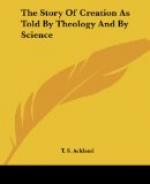A consideration of the mechanical conditions of the problem will show the unsoundness of Pontecoulant’s views. It is of course assumed that the forces by which this rotation is said to have been produced are identical in their character with those with which we are familiar, for the introduction of any force peculiar to that time would be equivalent to an admission of a directing power. The following propositions then seem unquestionable:—
1. The nebula must be considered as a system of particles acted on by their mutual attractions, and by no other force.
2. When two particles of matter, a and b, attract each other, it is a fundamental principle of mechanics, (commonly known as the “Third Law of Motion”) that whatever amount of momentum is produced in a, an equal and opposite momentum must be produced in b. Hence if the mutual action remain undisturbed, the two particles will approach each other and finally meet. On their union, the two momenta being equal and opposite will neutralize each other, and there will be no tendency to produce motion of any kind. 3. The same law will hold good with reference to any number of particles, and therefore with reference to the supposed nebula. Every single particle will produce a certain momentum in each of the other particles, and at the same time will have impressed upon it by each of the other particles an equal and opposite momentum. Hence when all the particles are collected into a single mass, each individual momentum will be balanced by an equal and opposite one, and there can be no resultant motion.
The analogy from fluids flowing through an orifice fails, because—
1. The particles of the fluid are acted on by forces other than their mutual attractions, and in many cases affecting them unequally, e. g., friction against the sides of the containing vessel and the orifice.
2. Because the orifice is not a point, but a finite area, and consequently the particles of the fluid are acted on by forces which do not pass through the same point.
Considered then as a substitute for the action of an intelligent Creator, Laplace’s theory utterly breaks down in three points, which, as they will have to be referred to hereafter, it is well to recapitulate.
1. It does not account for the origin of matter.
2. It does not account for the emergence of the force of attraction.
3. It does not give a satisfactory account for the motion of rotation.




